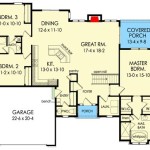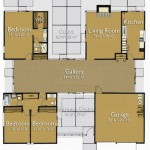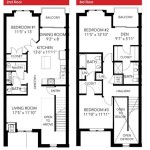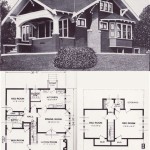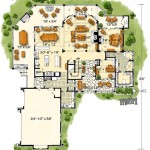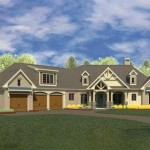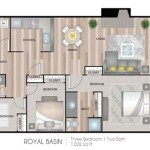House Plans With Open Floor Plans: A Comprehensive Guide
The open floor plan has become a prevalent design element in modern residential architecture. This architectural concept eliminates or minimizes the separation between common living areas, such as the living room, dining room, and kitchen, creating a larger, more unified space. The popularity of open floor plans stems from their perceived benefits in terms of natural light, social interaction, and flexibility. However, understanding the nuances of open floor plan design is crucial to ensure the resulting living space meets the needs and preferences of the occupants.
This article explores various aspects of house plans with open floor plans, including the advantages and disadvantages, design considerations, and different variations. It provides a comprehensive overview to assist homeowners in making informed decisions about incorporating open floor plans into their homes.
Advantages of Open Floor Plans
Open floor plans offer several advantages that contribute to their widespread appeal. These benefits can significantly enhance the living experience for homeowners.
Enhanced Natural Light and Ventilation: One of the significant benefits of an open floor plan is the increased flow of natural light throughout the connected spaces. With fewer walls obstructing the path of sunlight, natural light can penetrate deeper into the home, creating a brighter and more inviting atmosphere. Similarly, open floor plans often facilitate better ventilation. Air can circulate more freely throughout the connected spaces, leading to improved indoor air quality and a more comfortable living environment.
Increased Social Interaction: Open floor plans promote social interaction among family members and guests. The absence of walls allows individuals in different areas of the home to easily communicate and interact with one another. For instance, someone preparing a meal in the kitchen can still engage in conversation with individuals in the living area. This is particularly beneficial for families with young children, as parents can supervise their children while performing other tasks. Open floor plans also make entertaining easier, as guests can mingle freely between spaces without feeling isolated.
Flexibility and Adaptability: Open floor plans offer increased flexibility in terms of furniture arrangement and space utilization. The absence of fixed walls allows homeowners to easily reconfigure the layout of the living space to suit their changing needs. For example, a large open space can be used for multiple purposes, such as a living room, dining area, and home office. This adaptability is particularly advantageous for smaller homes, as it allows homeowners to maximize the use of the available space. Additionally, open floor plans can be easily adapted to accommodate different lifestyles and preferences.
Improved Sense of Spaciousness: By eliminating walls and visually connecting different areas, open floor plans create a sense of spaciousness. This is especially beneficial in smaller homes, where an open layout can make the space feel larger and more airy. The visual continuity between spaces eliminates the feeling of being confined to separate rooms, contributing to a more relaxed and comfortable living environment.
Disadvantages of Open Floor Plans
While open floor plans offer numerous benefits, they also have potential drawbacks that homeowners should consider. These disadvantages can impact the comfort and functionality of the living space.
Noise Transmission: One of the most significant disadvantages of open floor plans is the increased transmission of noise between spaces. Without walls to act as barriers, sounds can travel freely throughout the connected areas. This can be problematic for individuals who require quiet spaces for work or relaxation. For example, noise from the kitchen can easily disrupt someone trying to read or work in the living area. Similarly, noise from the television can interfere with conversations in the dining area. Effective soundproofing measures, such as the use of rugs, curtains, and acoustic panels, may be necessary to mitigate noise issues in open floor plans.
Lack of Privacy: The open nature of these designs can also lead to a lack of privacy. With fewer walls and defined spaces, it can be difficult to find a quiet, secluded area within the home. This can be a concern for individuals who value privacy or who require a dedicated workspace. To address this issue, homeowners may need to incorporate design elements such as screens, partitions, or strategically placed furniture to create more private zones within the open space.
Challenges with Heating and Cooling: Maintaining a consistent temperature throughout an open floor plan can be challenging. The large, interconnected space can make it difficult to regulate the temperature in different areas. For example, the kitchen area may become warmer during cooking, while the living area remains cooler. This can lead to energy inefficiencies and discomfort. To overcome this challenge, homeowners may need to invest in a zoned HVAC system that allows for independent temperature control in different areas of the home. Additionally, the placement of windows and doors should be carefully considered to minimize heat gain or loss.
Potential for Clutter: Open floor plans can be more susceptible to clutter than traditional layouts with separate rooms. The lack of defined spaces can make it easier for clutter to accumulate, creating a visually chaotic and overwhelming environment. Regular decluttering and organization are essential to maintain a clean and tidy open floor plan. Homeowners may also need to invest in storage solutions, such as built-in cabinets, shelves, and storage ottomans, to keep clutter out of sight.
Design Considerations for Open Floor Plans
Designing an effective open floor plan requires careful consideration of several factors, including space planning, furniture selection, and the use of visual cues to define different zones within the open space.
Defining Zones: While open floor plans eliminate physical barriers, it is important to create distinct zones within the space to delineate different functional areas. This can be achieved through various design techniques, such as:
- Furniture Placement: Arranging furniture in a way that defines specific areas, such as a living room seating arrangement or a dining area with a table and chairs.
- Floor Coverings: Using different types of flooring materials, such as hardwood in the living area and tile in the kitchen, to visually separate spaces.
- Area Rugs: Placing area rugs to define seating areas and add warmth and texture to the space.
- Lighting: Using different types of lighting fixtures, such as pendant lights over the dining table and recessed lighting in the kitchen, to highlight different zones.
- Architectural Details: Incorporating architectural details, such as columns, arches, or changes in ceiling height, to create visual separation between spaces.
Scale and Proportion: Selecting furniture and accessories that are appropriately scaled to the size of the open space is crucial. Overly large furniture can overwhelm a small open floor plan, while undersized furniture can get lost in a large space. It is important to consider the proportions of the furniture in relation to the overall dimensions of the room to create a balanced and harmonious design. Using a floor plan to map out furniture arrangements beforehand can prove beneficial.
Color and Texture: The strategic use of color and texture can enhance the visual appeal and cohesiveness of an open floor plan. Using a consistent color palette throughout the space can help to create a sense of unity. Adding texture through the use of different materials, such as fabrics, wood, and metal, can add visual interest and depth. It is important to consider how colors and textures interact with one another to create a balanced and harmonious design.
Traffic Flow: Careful consideration of traffic flow is essential to ensure that the open floor plan is functional and comfortable to use. The layout should allow for easy movement between different areas of the home without creating bottlenecks or obstructions. It is important to consider the placement of furniture, doorways, and hallways to create a smooth and intuitive traffic flow.
Storage Solutions: Integrating ample storage solutions into the design is crucial to keep the open floor plan organized and clutter-free. Built-in cabinets, shelves, and storage ottomans can provide ample space for storing belongings without taking up valuable floor space. It is important to consider the type and amount of storage needed based on the specific needs of the homeowners.
Sound Control: Addressing potential noise issues is essential for creating a comfortable and enjoyable living environment in an open floor plan. Soundproofing measures, such as the use of rugs, curtains, and acoustic panels, can help to absorb sound and reduce noise transmission. Additionally, the placement of appliances, such as dishwashers and washing machines, should be carefully considered to minimize noise levels.
By carefully considering these design considerations, homeowners can create an open floor plan that is both functional and aesthetically pleasing.

10 Small House Plans With Open Floor Blog Homeplans Com

Free Editable Open Floor Plans Edrawmax
:max_bytes(150000):strip_icc()/1660-Union-Church-Rd-Watkinsville-Ga-Real-Estate-Photography-Mouve-Media-Web-9-77b64e3a6fde4361833f0234ba491e29.jpg?strip=all)
18 Open Floor House Plans Built For Entertaining

Classic House Plans Open Floor Concept

Open Floor Plans Build A Home With Smart Layout Blog Dreamhomesource Com
10 Small House Plans With Open Floor Blog Homeplans Com

Open Concept Ranch Floor Plans Houseplans Blog Com

Open Floor Plans Build A Home With Smart Layout Blog Dreamhomesource Com

Free Editable Open Floor Plans Edrawmax

Modern Open Floor House Plans Blog Eplans Com

